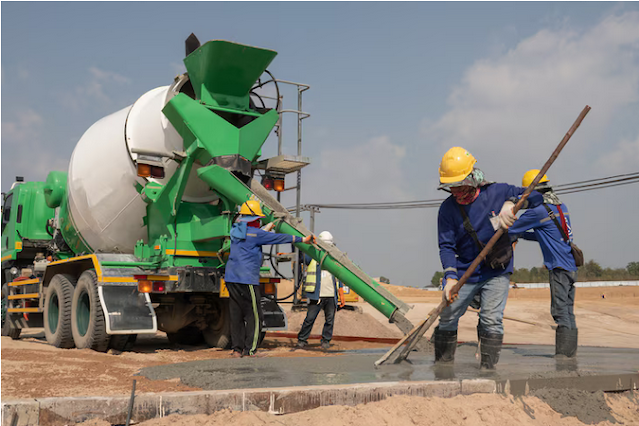Timely Pour: Navigating the Logistics of Concrete Delivery
Introduction
In the intricate ballet of construction, the efficient and timely delivery of concrete is a choreography that significantly influences the success of any project. As the backbone of structures, concrete plays a pivotal role, and its delivery involves a complex set of logistics to ensure that the right mix arrives at the right place and time. This article delves into the world of concrete delivery, exploring the logistics involved, the challenges faced, and the benefits of a well-orchestrated delivery process.
Components of Concrete Delivery Logistics:
Batching and Mixing: The process begins at the batching plant, where raw materials, including cement, aggregates, water, and admixtures, are precisely measured and mixed to create the desired concrete mix. Batching plants are equipped with advanced technology to ensure accuracy in proportions and quality control.
Transportation: Once the concrete is batched, the next step is transportation to the construction site. This involves the use of specialized vehicles such as transit mixers or agitator trucks. The choice of transportation method depends on factors such as the distance to the site, the volume of concrete required, and the specific requirements of the project.
Delivery Scheduling: Concrete delivery scheduling is a critical aspect of logistics. Coordination between the batching plant and the construction site is essential to ensure that the concrete arrives when needed. Factors such as traffic conditions, project timelines, and site readiness are considered in the scheduling process.
Pouring and Placement: Upon reaching the construction site, the concrete is poured or placed in the designated areas. This phase involves collaboration between the concrete delivery team and on-site personnel to ensure accurate placement according to the project specifications.
Quality Control: Throughout the entire process, quality control measures are implemented to monitor and maintain the quality of the concrete. This includes testing the concrete mix at the batching plant, during transportation, and at the construction site. Any deviations from quality standards are addressed promptly to prevent issues during placement.
Challenges in Concrete Delivery Logistics
Traffic and Transportation Constraints: Urban construction sites often face challenges related to traffic congestion and limited accessibility. Navigating through busy city streets can impact delivery schedules, requiring careful planning and coordination to minimize delays.
Weather Conditions: Adverse weather conditions, such as heavy rain or extreme temperatures, can pose challenges to concrete delivery. Concrete pouring during rainfall or in extremely hot weather requires additional considerations to maintain the integrity of the mix.
Site Readiness: The readiness of the construction site is crucial for seamless concrete delivery. Delays in site preparation, such as unloading areas not being clear or formwork not being ready, can impede the smooth flow of the delivery process.
Communication Challenges: Effective communication between the batching plant, transportation team, and on-site personnel is paramount. Any breakdowns in communication can lead to misunderstandings, resulting in delays or misplacement of the concrete.
Equipment Breakdowns: Mechanical failures or breakdowns in transit mixers or other equipment can disrupt the delivery process. Regular maintenance and a contingency plan for addressing equipment issues are essential to minimize downtime.
Benefits of Well-Managed Concrete Delivery
Timely Project Completion: Well-managed concrete delivery ensures that the material arrives at the construction site precisely when needed. This timely delivery contributes to the overall project schedule, preventing delays and facilitating the completion of construction projects on time.
Cost Efficiency: Efficient logistics in concrete delivery result in cost savings. Proper planning and coordination reduce idle time for equipment and labor, minimizing overall project costs. Additionally, avoiding delays can prevent costly disruptions to the construction schedule.
Quality Assurance: A well-managed delivery process includes stringent quality control measures. From batching plant to construction site, the concrete undergoes testing to ensure that it meets or exceeds the required quality standards. This quality assurance is crucial for the durability and longevity of the constructed structures.
Enhanced Safety: The coordination and communication inherent in well-managed concrete delivery contribute to a safer working environment. Adequate planning ensures that concrete is poured and placed safely, minimizing the risk of accidents and injuries on the construction site.
Optimized Resource Utilization: Efficient logistics allow for the optimized use of resources, including labor, equipment, and materials. By avoiding unnecessary delays and disruptions, construction teams can focus on tasks that contribute directly to project progress, maximizing resource utilization.
Innovations in Concrete Delivery Logistics
Real-Time Tracking: Advancements in technology have enabled real-time tracking of concrete delivery vehicles. GPS and tracking systems allow project managers to monitor the location and status of concrete trucks, enhancing visibility and control over the delivery process.
Automated Batching Systems: Automated batching systems in modern plants contribute to precision and efficiency in the mixing process. These systems use computer-controlled processes to ensure accurate proportions, reducing the likelihood of errors and inconsistencies in the concrete mix.
Data Analytics for Optimization: Data analytics tools are increasingly being used to analyze and optimize concrete delivery logistics. These tools consider historical data, traffic patterns, and other variables to develop predictive models that enhance scheduling and resource allocation.
Mobile Communication Platforms: Mobile communication platforms facilitate real-time communication between different stakeholders in the concrete delivery process. From batching plant operators to truck drivers and on-site personnel, mobile platforms ensure quick and effective communication, reducing the risk of misunderstandings and delays.
Conclusion
In conclusion, navigating the logistics of concrete delivery is a multifaceted process that requires meticulous planning, coordination, and adaptability. The challenges posed by traffic, weather conditions, site readiness, and communication can be overcome through innovative solutions and well-managed processes.
Well-executed concrete delivery logistics offer a myriad of benefits, including timely project completion, cost efficiency, quality assurance, enhanced safety, and optimized resource utilization. As the construction industry continues to evolve, the importance of efficient and precise concrete delivery becomes increasingly evident, paving the way for successful and resilient construction projects. By understanding the complexities and embracing innovations in concrete delivery logistics, construction teams can ensure a timely pour that lays the foundation for the structures of the future.




Comments
Post a Comment